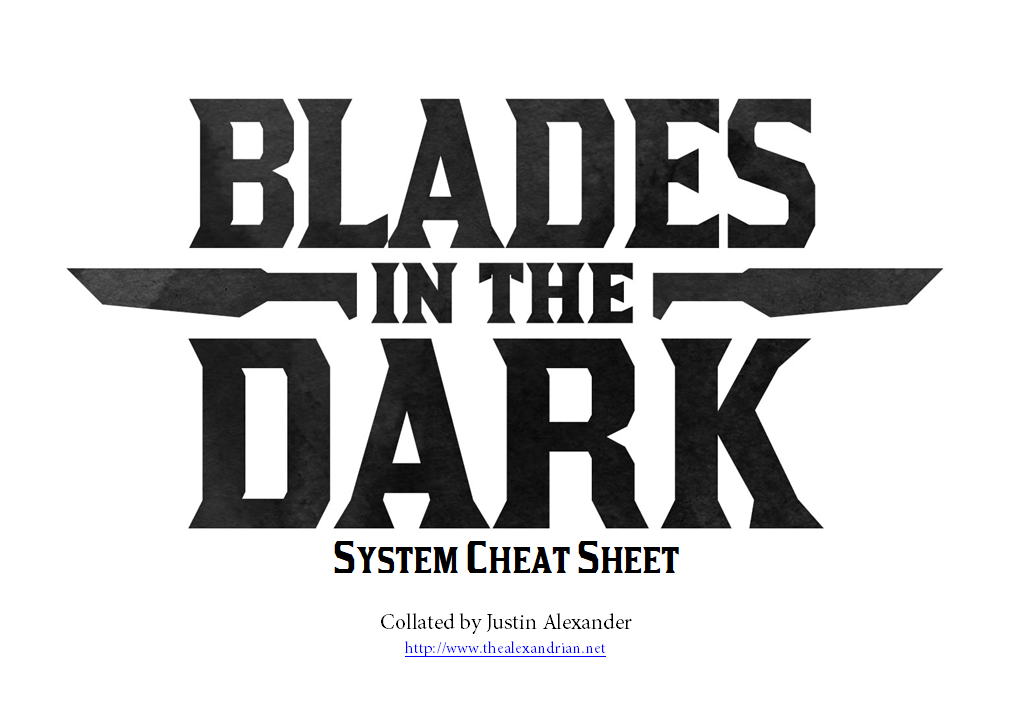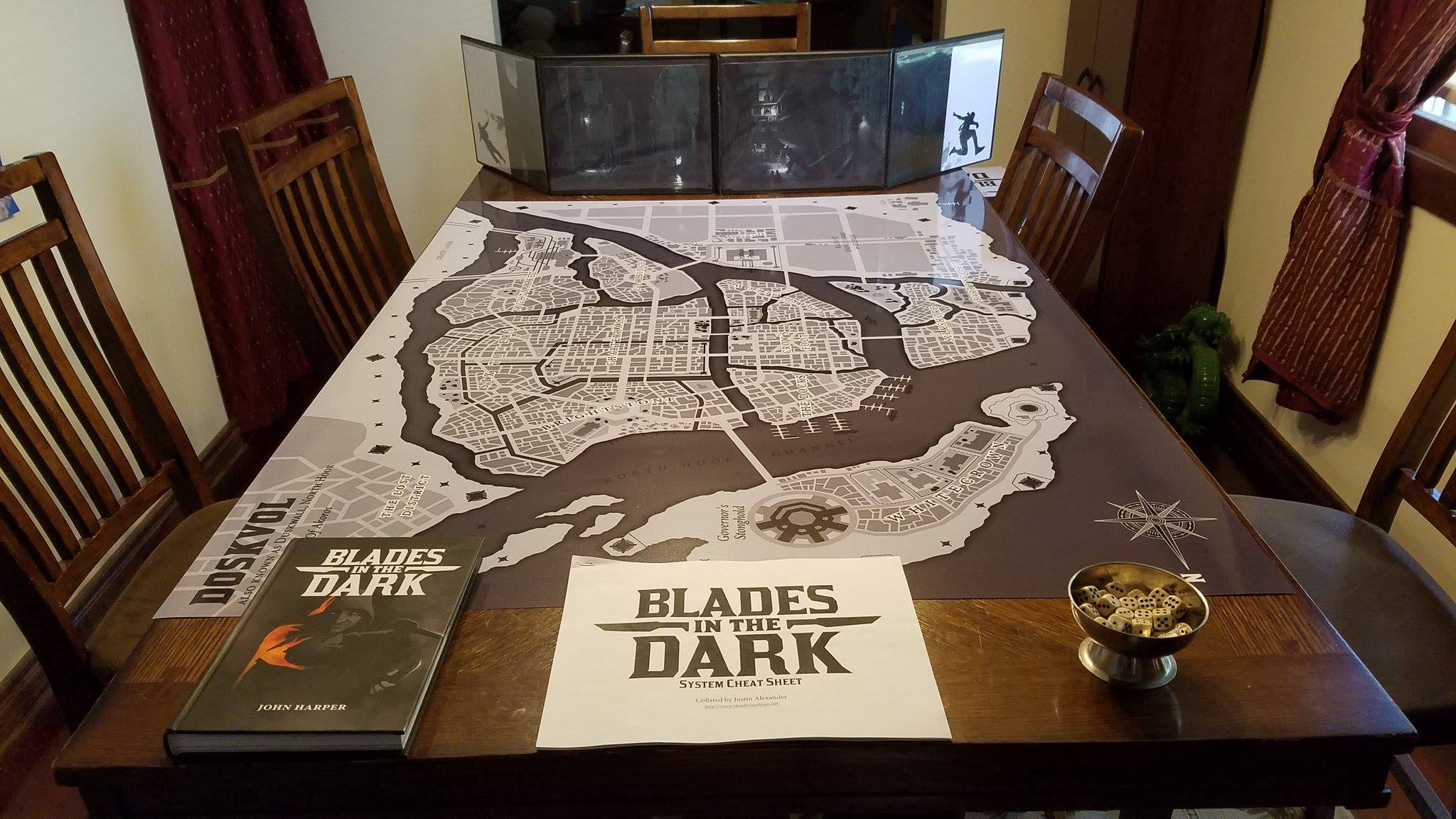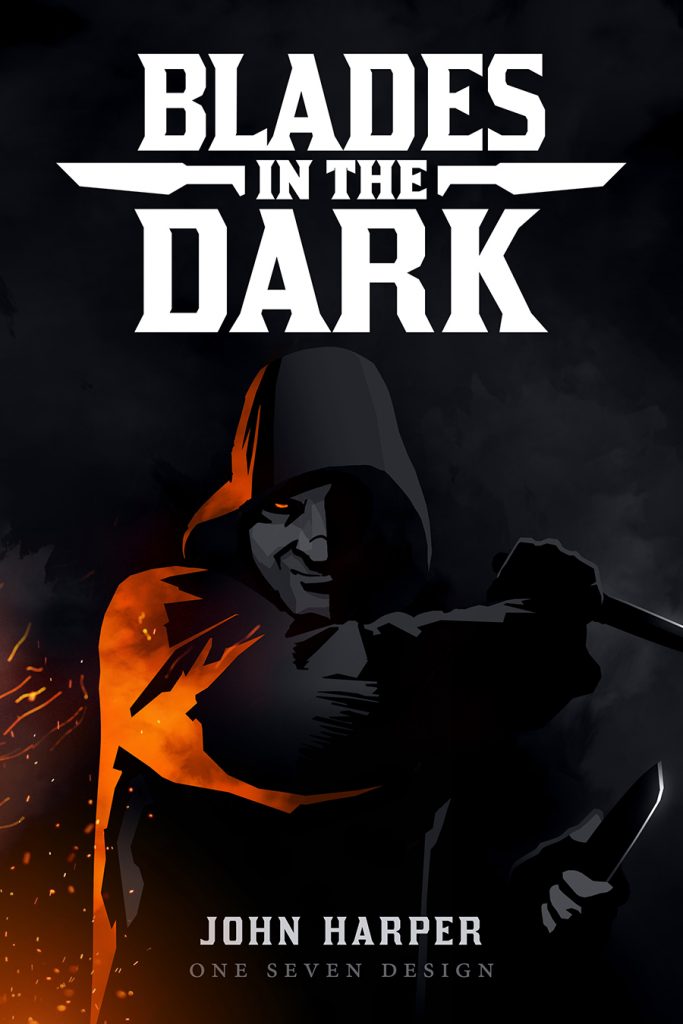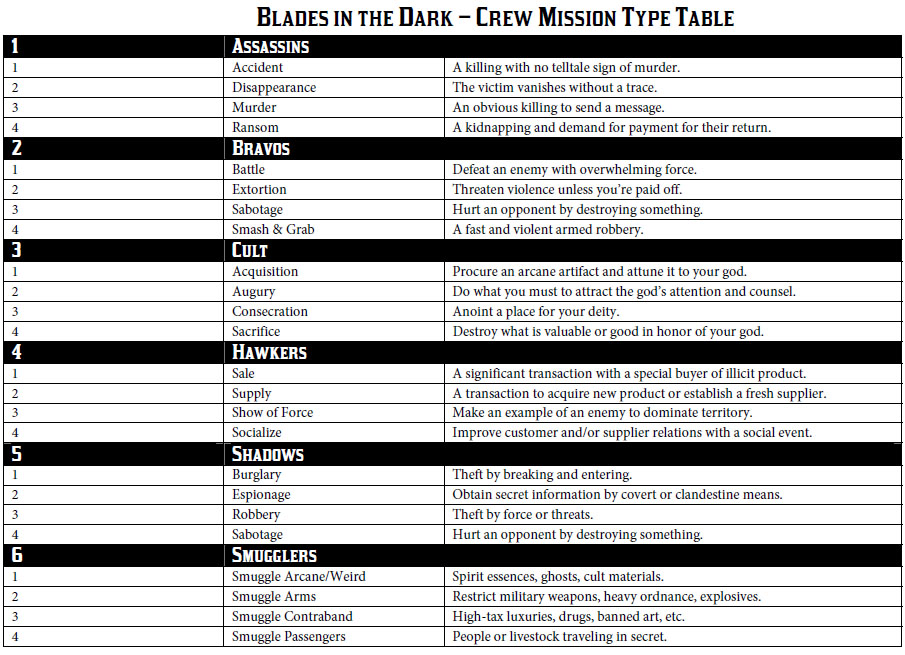
(click here for PDF)
Blades in the Dark is a really cool little game with three major claims to fame:
- A detailed system for running and developing a criminal crew.
- An innovative system for running heist scenarios using a combination of flashbacks and an “engagement roll”.
- A very unique approach to framing action resolution through a combination of setting position and level of effect.
As with my other cheat sheets, this cheat sheet is designed to summarize all of the rules for running the game — from Action Roll resolutions to Downtime activities. It is not, however, designed to be a quick start packet: If you want to learn how to play Blades in the Dark, you’ll want to read through the core rulebook. These cheat sheets are a long-term resource for both GMs and players, and can serve as a great tool for experienced players teaching newcomers, but it’s a cheat sheet, not a textbook.
These cheat sheets also do not include what I refer to as “character option chunks” (for reasons discussed here). You won’t find the rules for character creation, the character playbooks, or the crew sheets here. (Although you can find many of those resources at bladesinthedark.com.)
VERSION 3
My normal procedure for creating these cheat sheets is to (a) write them up, (b) use them in actual play for several sessions, (c) iteratively revise them as necessary, and only then (d) share them here on the Alexandrian. For Blades in the Dark, however, I posted a picture to Twitter of my table set-up for the game:

The sexy map (printed by ABC Sign & Graphic) drew a lot of attention, and the prominent positioning of the cheat sheets unexpectedly created a lot of demand for them. This sort of short-circuited my normal process and, after using them in only a single session, I rushed them up onto the site.
Since that time, however, I’ve used the sheets in almost a dozen more sessions and it became clear that there were not only a number of errors, but also some significant shortcomings with them. These new versions of the sheets, therefore, have reorganized the existing material to configure it more usefully, but also added several significant new chunks of information:
- Duskvol District Modifiers: Getting these in front of the players has a really tangible effect on how they organize their affairs and run their scores.
- Glossary of Strange Forces: I found that our group was getting a little too “fantasy generic” in my handling of the setting, so I wanted to refocus myself on the very specific “demonic steampunk ghost apocalypse” vibe of the game.
- Action Ratings – Expanded Reference: I’d originally decided not to include this material and went with my normal “list of attributes/skills” method for cheat sheets. But the clear definition of what each action rating is for and, even more importantly, where those action ratings weakly overlap is actually really crucial to running Blades in the Dark correctly. During play we were constantly reaching for the rulebook to look this stuff up, which is exactly the material you want in the cheat sheet.
If you still want the original versions of these cheat sheets, they can still be found here.
HOW I USE THEM
I usually keep a copy of my system cheat sheets behind my GM screen for quick reference and I also place a half dozen copies in the center of the table for the players to grab as needed. The information included is meant to be as comprehensive as possible; although rulebooks are also available, my goal is to minimize the amount of time people spend referencing the rulebook: Finding something in the 8 pages of the cheat sheet is a much faster process than paging through the full rulebook. And, once you’ve found it, processing the streamlined information on the cheat sheet will (hopefully) also be quicker.
The organization of information onto each page of the cheat sheet should, hopefully, be fairly intuitive.
Page 1-2: Core Resolution. This includes all of the core rules for action resolution, including action rolls, resistance rolls, fortune rolls, consequences, harms, stress, and progress clocks (plus additional resources related to those topics).
Page 3-4: Scores & Crews & Factions. Re-sequencing this material made the cheat sheet more intuitive to navigate. I’ve also dropped Incarceration rules onto page 4.
Page 5-6: Downtime. And once your score is done, everything you need for downtime activities (including vices).
Page 7: Miscellanea. Collecting together rules for Coins, Rituals, and Crafting.
Page 8: Deep Reference. The new references for Duskvol District Modifiers, Glossary of Strange Forces, and the Expanded Reference for Action Ratings. (Obviously you’d want to swap out the Duskvol modifiers if you’re running with a different setting, such as U’Duasha from the special edition of the game.)
Page 9: Principles. This page includes the game’s “core loop”, the standards for who controls which types of decisions (Judgment Calls), and the best practices/goals for players and GMs alike.
MAKING A GM SCREEN
These cheat sheets can also be used in conjunction with a modular, landscape-oriented GM screen (like the ones you can buy here or here).
I usually use a four-panel screen and use reverse-duplex printing in order to create sheets that I can tape together and “flip up” to reveal additional information behind them. After some experimentation, this is the set-up I’m currently using for Blades in the Dark:
- Panel 1: Action / Effect (with Deep References behind it)
- Panel 2: Consequences / Progress Clocks / Magnitude
- Panel 3: Scores (with Crews and Principles behind it)
- Panel 4: Downtime (with Downtime Activities and Miscellanea behind it)
This allows you to reference roll results, consequences, and the magnitude table with a single glance to your left. You can intuitively flip up the Action Rating page to find the expanded Action Rating material behind it. To your right you’ll be able to flip through the material for Scores & Downtime on the final two panels (with miscellaneous details tucked behind each).
Something else I experimented with was leaving a panel open and sliding in the one-page reference for the current District. But as the action in my campaign seems to frequently shift betweeen districts, this ended up being more finicky than valuable.
It’s likely that these sheets will continue to evolve through play. Recently, for example, I’ve realized that I really want a reference for the different hours of the day (Blades in the Dark, p. 240) so that I can set the time of night more accurately. (This is perhaps particularly notable because the setting’s eternal night disrupts my normal time descriptors.) You might jot those down on the currently blank sheet on Panel 1. Maybe it would be useful to pair that with a map of Doskvol you could flip up to reference quickly?
FURTHER READING
Advanced Starting Situations
Alternative Starting Situations
Progress Clocks
The Vultures




















